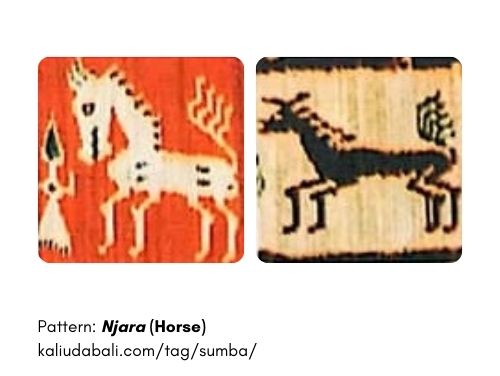2 weeks ago, we discussed the History of Sumba Ikat. In this article, we summarize from several sources about the motifs and meanings contained in the Sumba Ikat. Judging from the objects drawn, the motifs of the ikat cloth of East Sumba can be classified into two: First, pictures taken from the world of fauna and flora. Second, pictures are taken from the human world itself.
Sumba Ikat Motifs
These Sumba Ikat Motifs will be divided into 5 separate articles. The following are the motifs that will be explained in a series of articles on Sumba Ikat motifs:
PART 1
World of Fauna & Flora
- Wita (Octopus)
- Njara (Horse)
Kambiha Njara (Horse Tread)
PART 2
- Kaka (Cockatoo)
Piriihu (Parrot)
Manginu (Sparrows)
- Kataru Mbakul (Snake)
- Ruha (Deer)
- Kurangu (Shrimp)
- Karunggu (Crab)
- Iyang (Fish)
- Wuya (Crocodile)
The red crocodile and the scaly turtle
- Karawulangu (Turtle)
- Dragon
PART 3
- Elephant
- Mahang (Lion)
Mahang Katiku Njara (Horse-Headed Lion), Mahang Katiku Tau (Human-Headed Lion), Mahang Hawurung (Flying Lion)
- Kahuhu (Coastal Little Bird)
- Habaku / Kumbulai Hawurung (Flying Lizard)
- Karihu (Dedap Flower)
- Readi (Duck)
- Walla Watar (Cornflower)
- Flora
- Manu Marra (Peacock)
- Rau Au (Bamboo Leaves)
- Karambua (Buffalo)
- Kawung (Monkey)
PART 4
Human World
- Patuala / Patola
Patola Bunga, Patola Kamba, Patola Ratu
- Tau (Human)
- Andungu Katiku Tau (Human Skull Monument)
PART 5
- Wilhelmina (Queen of the Netherlands)
- Mamuli
- Tau Rianja (Dancing People)
- Pasola
- Liakat (Stairs Up & Stairs Down)
- Tiana (Boat)
- Kandunnu (Star)
- Buanda
- Hiamba Roti
- Hunda Rangga
- Ukki / Mata Ndui (Currency)
- Papanggang (Queen Kara Wulang)
- Upacara Weli Meti Lundu Taning (Death to Burial Ceremony)
- Mata Hutar
- Walla Mangata
Let’s just discuss the first part of the Sumba Ikat Motifs.
World of Fauna & Flora
The first group includes horses, roosters, ducks, cockatoos, snakes, deer, shrimp, crocodiles, turtles, seabirds, flying centipede/geckos, elephants, and lions (fauna). The world of flora includes the Kalpataru tree, Dedap flower, lotus flower.
The world of fauna is further divided into the domestic and the external in the form of imitated images such as lions and elephants. The lack of courage to draw these two animals before any connection with India and the Netherlands reinforces the notion that Sumba does not have lions and elephants. This is further strengthened by Wallace’s theory which divides the world of fauna in Indonesia into two. It is said, in eastern Indonesia, there are no lions, tigers, or elephants.
Although some animals are not on Sumba…
In fact, in Sumba, life thrives on stories about meurumba (a giant wild cat) as a picture of lions and tigers, as well as elephants. In Sumba, there are two places that immortalize the name meurumba, namely in Kodi, Southwest Sumba, and in Masu, East Sumba. The word elephant is found in a number of people’s names in East Sumba. The discovery of the stegedon mandible (jaw) of elephants in Watumbaka (14 km from Waingapu) on 26 August 1978 and in Lewa sub-district in October 1977, November 1981, and October 3, 1982, has actually dispelled the myth that does not believe elephants ever lived in Sumba.
Why weren’t lions and elephants drawn before any contact with the outside world? It is very possible that the animals had become extinct when the first humans landed on Sumba (old proto Malay). Because according to Panji Manu, Cultural Inspector of East Sumba Regency when the Lewa stegedon was found, who confirmed to the Jakarta Archaeological Research Center, the elephant jaw found was 45,000 years old. So elephants and lions are only vague in their memories when they are in the area of origin until the arrival of contact that revives their memories.
1. Wita (Octopus)
This motif or pattern symbolizes the greatness of a leader who is able to embrace and protect and be wise. In the East Sumba language, it is called “pa opangu madangu“. This pattern is commonly found in Pahikung/Pahudu/songket weaving in East Sumba. Produced by the Umalulu District and is a Patent of the former Umalu Swapraja in East Sumba.

Sumba Ikat Motifs Wita (Octopus)
This pattern is a symbol of the spirit’s journey to immortality.
2. Njara (Horse)

Sumba Ikat Motifs Njara (Horse)
Horses are versatile livestock, function as a means of transportation, are used in war, determine social status, and even have high economic value. In culture, the horse is an important symbol in marriage customs and a vehicle symbol for the dead in death customs. Horses symbolize masculinity, authority, majesty, courage, agility, heroism, and unity.

Sumba Ikat Motifs Kambiha Njara ( Horse Tread)
Kambiha Njara or this horse tread-inspired symbol is a symbol of prosperity.
3. Manu (Rooster)
Roosters are specially reared to be used as sacrificial animals in the implementation of the MARAPU belief ritual.

Sumba Ikat Motifs Manu (Rooster)
There is a piece of advice or advice for Sumbanese women who want to get married in the traditional Sumbanese literary language, namely: “ambu ma rombanya na kurunggu panni manu, na uta uhu wei” which means don’t forget chicken groats and pork bran. This symbolizes the main work of Sumba women is raising chickens and pigs for the necessities of life.
The Rooster symbol represents “Awareness” meaning the rooster always crows before sunrise and wakes people up in the morning. In addition, it is also a symbol of “manliness”, “sign of life”, and “protective leader”. The hen is a symbol of unity. While the rooster symbolizes masculinity.
Next
It is truly a precious natural heritage that we should cherish. Mesmerized by the variety of Sumba ikat motifs and patterns, the specialty of Sumba Woven fabric doesn’t stop here. Want to know more about each motif, detail, and creature that we can identify that appear on Sumbanese textiles? Stay tuned next week for “Sumba Ikat Motifs: Fauna – Part 2”.
Source:
